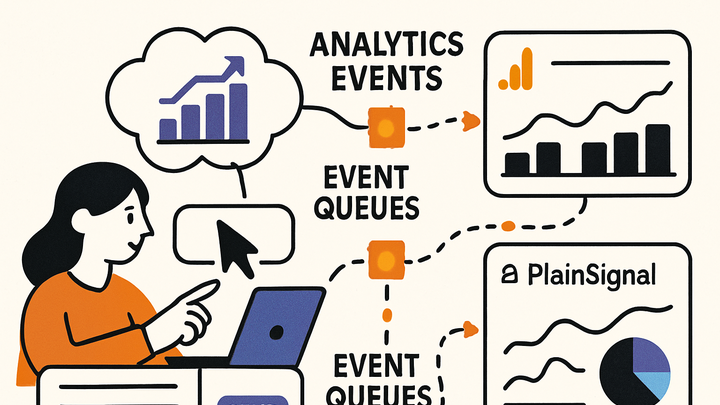Published on 2025-06-28T00:03:49Z
What is an Analytics Event? Examples and Implementation
An analytics event is a discrete, action-oriented data point that captures specific user interactions within a website or application. These events go beyond simple pageviews to include clicks, form submissions, video plays, and other meaningful user activities. By recording events, businesses gain granular insights into user behavior, enabling them to optimize UX flows, marketing campaigns, and product features. Popular analytics platforms like Google Analytics 4 (GA4) and cookie-free solutions such as PlainSignal support both automatic and custom event tracking. Implementing events involves adding snippets of JavaScript code or using tag managers to fire events with relevant parameters. Over time, well-structured events form the backbone of data-driven decision-making and growth strategies.
Analytics event
An Analytics Event tracks specific user actions or interactions, enabling detailed behavioral insights for data-driven decision-making.
Why Analytics Events Matter
Analytics events provide a window into individual user actions, revealing how people engage with your site or app. They help identify drop-off points, optimize funnels, and measure the impact of feature changes or marketing campaigns. Without events, you would only know what pages users visit, not how they interact. Granular event data empowers teams to test hypotheses, segment audiences, and personalize experiences.
-
Understanding user behavior
Events capture specific user actions—like clicks and form submissions—to show how users navigate and interact with your interface.
-
Driving data-driven decisions
You can mark key milestones such as purchases or sign-ups to optimize conversion rates and allocate marketing spend more effectively.
-
Customizable tracking
Events can be tailored to your unique business goals, ensuring you collect only the data that matters most for your KPIs.
Types of Analytics Events
Analytics platforms often categorize events into automatic (system-collected) and custom (user-defined) types. Understanding these helps you choose the right events to instrument and avoid data overload.
-
Automatic events
Pre-defined events tracked by default, such as
page_view,first_visit, orsession_startin GA4. They require minimal setup. -
Custom events
Events you define for actions specific to your product—like
button_click,video_play, orform_submission. They provide tailored insights.
Implementing Analytics Events
Different analytics platforms offer various ways to fire events. Below are examples for GA4 and PlainSignal, a simple, cookie-free analytics solution.
-
Google analytics 4 (GA4)
GA4 uses
gtag.jsor Google Tag Manager. You configure events by callinggtag('event', ...), sending rich parameters for deeper analysis.-
GA4 implementation example
<!-- Global site tag (gtag.js) - Google Analytics --> <script async src="https://www.googletagmanager.com/gtag/js?id=GA_MEASUREMENT_ID"></script> <script> window.dataLayer = window.dataLayer || []; function gtag(){dataLayer.push(arguments);} gtag('js', new Date()); gtag('config', 'GA_MEASUREMENT_ID'); // Custom event example gtag('event', 'purchase', { currency: 'USD', value: 59.99, transaction_id: 'T12345' }); </script>
-
-
PlainSignal
PlainSignal is a lightweight, cookie-free analytics tool that lets you capture events with minimal setup. You add a single script tag and then call its global function to send events.
-
PlainSignal implementation example
<link rel="preconnect" href="//eu.plainsignal.com/" crossorigin /> <script defer data-do="yourwebsitedomain.com" data-id="0GQV1xmtzQQ" data-api="//eu.plainsignal.com" src="//cdn.plainsignal.com/plainsignal-min.js"></script> <script> // Custom event example window.PlainSignal('event', 'signup_completed', { plan: 'pro', source: 'landing_page' }); </script>
-
Best Practices for Analytics Events
Implementing events thoughtfully ensures clean data and actionable insights. Follow these best practices to maintain a reliable event tracking system.
-
Consistent naming conventions
Use clear, descriptive names in a consistent format (e.g.,
category_action_label) so teams can understand event purposes at a glance. -
Limit and prioritize events
Track only the most impactful events to avoid data noise and performance overhead. Review and prune rarely-used events regularly.
-
Include relevant parameters
Attach contextual data (e.g.,
value,currency,button_text) to events for richer analysis and segmentation. -
Validate and debug
Use platform debuggers and QA environments to verify events fire correctly and carry accurate data before going live.
Use Cases and Examples
Analytics events power insights across different domains. Here are common scenarios where they’re essential:
-
E-commerce purchase tracking
Capture events for product views, add-to-cart, and purchases to analyze conversion funnels and revenue attribution.
-
User engagement metrics
Track video plays, file downloads, and social shares to measure content effectiveness and engagement rates.
-
Form analytics
Monitor form starts, completions, and error events to optimize form design and reduce abandonment.
